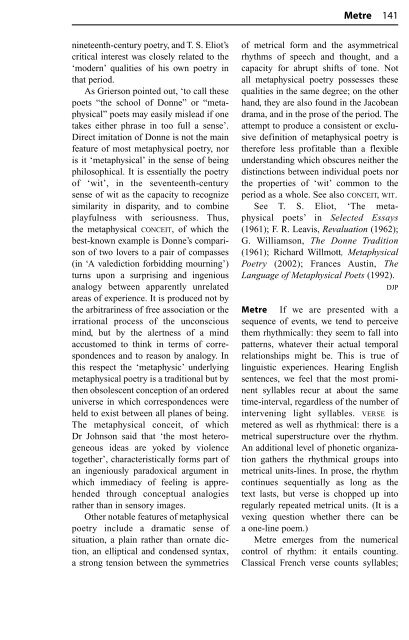The Routledge Dictionary of Literary Terms
The Routledge Dictionary of Literary Terms
The Routledge Dictionary of Literary Terms
You also want an ePaper? Increase the reach of your titles
YUMPU automatically turns print PDFs into web optimized ePapers that Google loves.
nineteenth-century poetry, and T. S. Eliot’s<br />
critical interest was closely related to the<br />
‘modern’ qualities <strong>of</strong> his own poetry in<br />
that period.<br />
As Grierson pointed out, ‘to call these<br />
poets “the school <strong>of</strong> Donne” or “metaphysical”<br />
poets may easily mislead if one<br />
takes either phrase in too full a sense’.<br />
Direct imitation <strong>of</strong> Donne is not the main<br />
feature <strong>of</strong> most metaphysical poetry, nor<br />
is it ‘metaphysical’ in the sense <strong>of</strong> being<br />
philosophical. It is essentially the poetry<br />
<strong>of</strong> ‘wit’, in the seventeenth-century<br />
sense <strong>of</strong> wit as the capacity to recognize<br />
similarity in disparity, and to combine<br />
playfulness with seriousness. Thus,<br />
the metaphysical CONCEIT, <strong>of</strong> which the<br />
best-known example is Donne’s comparison<br />
<strong>of</strong> two lovers to a pair <strong>of</strong> compasses<br />
(in ‘A valediction forbidding mourning’)<br />
turns upon a surprising and ingenious<br />
analogy between apparently unrelated<br />
areas <strong>of</strong> experience. It is produced not by<br />
the arbitrariness <strong>of</strong> free association or the<br />
irrational process <strong>of</strong> the unconscious<br />
mind, but by the alertness <strong>of</strong> a mind<br />
accustomed to think in terms <strong>of</strong> correspondences<br />
and to reason by analogy. In<br />
this respect the ‘metaphysic’ underlying<br />
metaphysical poetry is a traditional but by<br />
then obsolescent conception <strong>of</strong> an ordered<br />
universe in which correspondences were<br />
held to exist between all planes <strong>of</strong> being.<br />
<strong>The</strong> metaphysical conceit, <strong>of</strong> which<br />
Dr Johnson said that ‘the most heterogeneous<br />
ideas are yoked by violence<br />
together’, characteristically forms part <strong>of</strong><br />
an ingeniously paradoxical argument in<br />
which immediacy <strong>of</strong> feeling is apprehended<br />
through conceptual analogies<br />
rather than in sensory images.<br />
Other notable features <strong>of</strong> metaphysical<br />
poetry include a dramatic sense <strong>of</strong><br />
situation, a plain rather than ornate diction,<br />
an elliptical and condensed syntax,<br />
a strong tension between the symmetries<br />
Metre 141<br />
<strong>of</strong> metrical form and the asymmetrical<br />
rhythms <strong>of</strong> speech and thought, and a<br />
capacity for abrupt shifts <strong>of</strong> tone. Not<br />
all metaphysical poetry possesses these<br />
qualities in the same degree; on the other<br />
hand, they are also found in the Jacobean<br />
drama, and in the prose <strong>of</strong> the period. <strong>The</strong><br />
attempt to produce a consistent or exclusive<br />
definition <strong>of</strong> metaphysical poetry is<br />
therefore less pr<strong>of</strong>itable than a flexible<br />
understanding which obscures neither the<br />
distinctions between individual poets nor<br />
the properties <strong>of</strong> ‘wit’ common to the<br />
period as a whole. See also CONCEIT, WIT.<br />
See T. S. Eliot, ‘<strong>The</strong> metaphysical<br />
poets’ in Selected Essays<br />
(1961); F. R. Leavis, Revaluation (1962);<br />
G. Williamson, <strong>The</strong> Donne Tradition<br />
(1961); Richard Willmott, Metaphysical<br />
Poetry (2002); Frances Austin, <strong>The</strong><br />
Language <strong>of</strong> Metaphysical Poets (1992).<br />
DJP<br />
Metre If we are presented with a<br />
sequence <strong>of</strong> events, we tend to perceive<br />
them rhythmically: they seem to fall into<br />
patterns, whatever their actual temporal<br />
relationships might be. This is true <strong>of</strong><br />
linguistic experiences. Hearing English<br />
sentences, we feel that the most prominent<br />
syllables recur at about the same<br />
time-interval, regardless <strong>of</strong> the number <strong>of</strong><br />
intervening light syllables. VERSE is<br />
metered as well as rhythmical: there is a<br />
metrical superstructure over the rhythm.<br />
An additional level <strong>of</strong> phonetic organization<br />
gathers the rhythmical groups into<br />
metrical units-lines. In prose, the rhythm<br />
continues sequentially as long as the<br />
text lasts, but verse is chopped up into<br />
regularly repeated metrical units. (It is a<br />
vexing question whether there can be<br />
a one-line poem.)<br />
Metre emerges from the numerical<br />
control <strong>of</strong> rhythm: it entails counting.<br />
Classical French verse counts syllables;

















